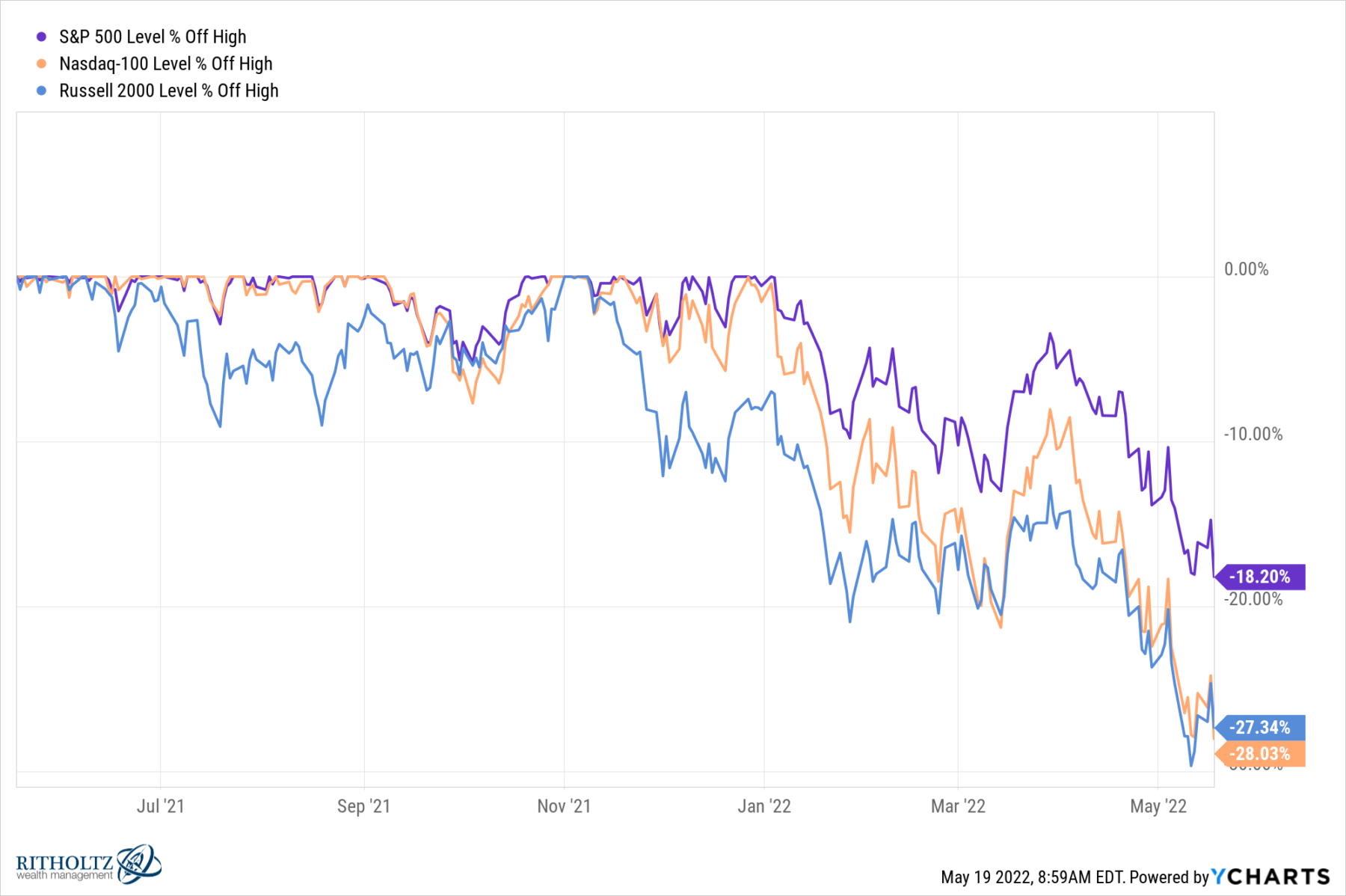Yesterday’s market bloodbath brought the S&P 500 down more than 18% from its highs; the NASDAQ is now more than 27% off its peak and the Russell 2000 more than 28%.
It’s never too early to begin preparing for whatever capitulation occurs and market lows are eventually made, whether they turn out to have been yesterday or happen six months from now.
I have had some luck — and a few disasters — buying into big messes over the years. Here are some ideas that have worked for me over the past few decades. Consider if any of these might be useful to you as you start making a wish list and begin thinking about how to use this drawdown opportunistically:
1. Begin Humbly: We never know how far these drawdowns will go or how long they will last. Is this a shallow 20% pullback? A 30% crash? Worse? (We don’t know). 2020’s 34% crash barely lasted a month, the 2008-09 GFC ran for 18 months, and 1966-1982 bear market was 16 years long.
Begin your plan by acknowledging you are venturing into the unknown. Never bet the farm or assume so much risk that an entire portfolio can be destroyed if the underlying premise turns out to be early (aka “wrong”).
2. Seek Asymmetry: Look for opportunities that have much greater upside than potential downside. Traders never know which of their positions will work out or not in advance. There is value in creating a potential for net gains, even if you only bat .300.
3. Automate: The best-intentioned bottom buyers often fail to execute trades (despite their own desires) out of fear and emotion. Remove your limbic system from the process by deciding upon a series of entries, and then automating them.
4. Buy Over Time: Rather than guessing a specific “ideal” entry date mid-sell off, consider spreading out your purchases across months. Pick six dates over the next year with chunks of your discretionary trading capital. This guarantees you will be both early and late – but it also creates a high probability your average purchase price will be considerably lower than where the market is six months into the recovery.
5. Buy Across Prices Levels: Another approach to avoid guessing the bottom is to make multiple purchases at different price levels: Example: Set GTC limit purchase orders to buy a broad index down 19%, 26%, 33%, 42%, even 53%. (I like to avoid round numbers). If only half of your orders get executed it means markets avoided matching some of the worst downturns of the past 50 years – but you were still a buyer at advantageous prices.
6. Favorite Stocks: As much as I like broad indices, some folks have their favorite companies. Consider the ones that may have run away from you last cycle that you would like to own long term. Whether its Nvidia or Apple or whatever your personal fave, follow the same strategy of making multiple purchases across different price levels.
7. Use Options Sparingly: We keep hearing anecdotes about Robin Hood/Reddit traders who used options to great effect in 2021 but saw terrible results in 2022. The Pros use options as way to manage their risk – essentially defining their losses in advance.
Example: Instead of buying $100k of a position with a 10% stop loss, they purchase $10k in long-dated calls. Time decay makes the risk parameters between stocks and options differ dramatically, but if used properly this can be a useful strategy.
8. Shorting is Hard: To get a short trade right, you have to first identify something heading appreciably lower; second, get your timing right, and last, borrow the shares. All of this is harder than it sounds: Shorts can get squeezed, borrowed stock gets called away, costs accumulate, and the timing can be notoriously difficult.
9. Avoid Leverage: Using borrowed money to make speculative market crash purchases is a recipe for disaster. Do not do it! As Gerald Loeb wrote in 1935, this is about more than mere gains, it is a battle for investment survival.
10. Be Patient + Stick to Your Plan: Buying into a correction, bear market or crash is a challenge that very few people can do well. It takes planning, patience, and lots of time to unfold.
These 10 ideas have proven helpful to me over time; your list might include 10 completely different approaches. But whatever your approach is to buying into a correction or crash, thinking it through and having a plan is the best recipe for success, regardless of the specific ingredients.
Previously:
Panic Selling Quantified (March 24, 2022)
If You Sell Now, When Do You Get Back In? (March 23, 2022)
Don’t Panic! (with apologies to Douglas Adams) (March 9, 2020)
The Plural of Anecdote IS Data (February 4, 2019)
Have a plan, and stick to it. (July 2, 2016)


